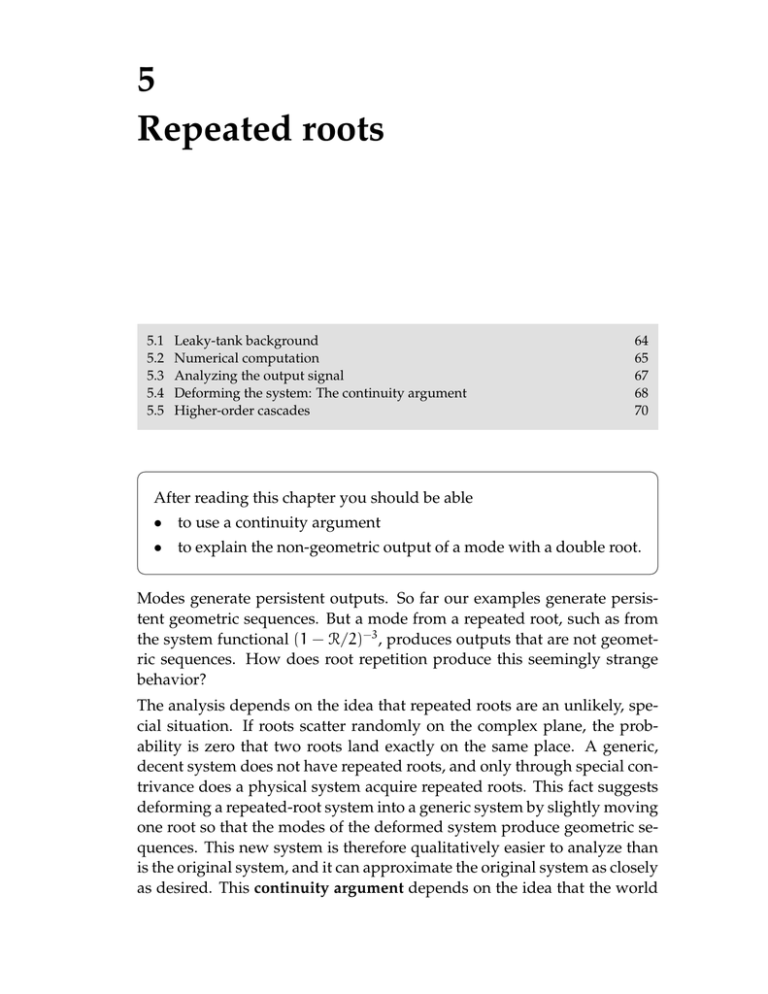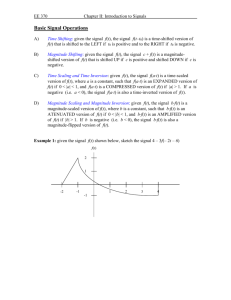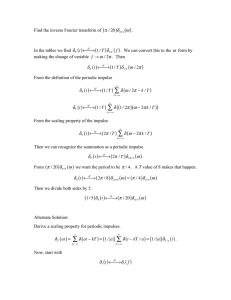5 Repeated
advertisement

5 Repeated roots 5.1 5.2 5.3 5.4 5.5 Leaky-tank background Numerical computation Analyzing the output signal Deforming the system: The continuity argument Higher-order cascades 64 65 67 68 70 After reading this chapter you should be able • to use a continuity argument • to explain the non-geometric output of a mode with a double root. Modes generate persistent outputs. So far our examples generate persis­ tent geometric sequences. But a mode from a repeated root, such as from the system functional (1 − R/2)−3 , produces outputs that are not geomet­ ric sequences. How does root repetition produce this seemingly strange behavior? The analysis depends on the idea that repeated roots are an unlikely, spe­ cial situation. If roots scatter randomly on the complex plane, the prob­ ability is zero that two roots land exactly on the same place. A generic, decent system does not have repeated roots, and only through special con­ trivance does a physical system acquire repeated roots. This fact suggests deforming a repeated-root system into a generic system by slightly moving one root so that the modes of the deformed system produce geometric se­ quences. This new system is therefore qualitatively easier to analyze than is the original system, and it can approximate the original system as closely as desired. This continuity argument depends on the idea that the world 5.1 Leaky-tank background 64 changes smoothly: that a small change to a system, such as by moving a root a tiny amount, produces only a small change to the system’s output. To generate a double root, we use the RC circuit (??) or the leaky tank (Section 1.2). Either system alone has one mode. To make a double root, cascade two identical tanks or RC circuits, where the output of the first system is the input to the second system. Exercise 26. When making an RC cascade system analogous to a cascade of two leaky tanks, does the RC cascade need a unity-gain buffer between the two RC cir­ cuits? 5.1 Leaky-tank background Let the leaky tank or RC circuit have time constant τ. Let Vin be the input signal, which is the flow rate into the tank system or the input voltage in the RC circuit, and let Vout be the output signal. Then the differential equation of either system is τV̇out = Vin − Vout . Convert this equation into a discrete-time system using the forward-Euler approximation (??). Using a time step T , the difference equation becomes τ Vout [n] − Vout [n − 1] = Vin [n − 1] − Vout [n − 1]. T To promote equation hygiene, define the dimensionless ratio ≡ T/τ and collect like terms. The clean difference equation is Vout [n] − (1 − )Vout [n − 1] = Vin [n − 1]. Pause to try 23. What system functional corresponds to this differ­ ence equation? The corresponding system functional is 5 Repeated roots 65 Vout R = . 1 − (1 − )R Vin Exercise 27. What block diagram corresponds to this system functional? A double root arises from cascading two identical systems. Here is its high- level block diagram showing the input, intermediate, and output signals: V0 leaky tank or RC circuit V1 leaky tank or RC circuit V2 Its system functional is the square of the functional for one system: � �2 V2 R = . 1 − (1 − )R V0 The numerator (R)2 does not add interesting features to the analysis, so simplify life by ignoring it. To simplify the algebra further, define β = 1−. With that definition and without the boring R factor, the purified system is 1 V2 = . V0 (1 − βR)2 5.2 Numerical computation By design, this cascade system has a double root at β = 1 − . Let’s simu­ late its impulse response and find patterns in the data. Simulation requires choosing numerical values for the parameters, and here the only parameter is = T/τ. An accurate discretization uses a time step T much shorter than the system time constant τ; otherwise the system changes significantly be­ tween samples, obviating the discrete-time approximation. So use 1. Pause to try 24. Write a program to simulate the impulse response, choosing a reasonable or β. 5.2 Numerical computation 66 The following simulation uses = 0.05 or β = 0.95 in computing the impulse response: from scipy import * N = 100 impulse = zeros(N) impulse[0] = 1 beta = 0.95 # return the output signal from feeding INPUT signal through a system # with a feedback loop containing a delay and the given GAIN. def onestage(input, gain): output = input * 0 output[0] = input[0] for i in range(1,len(output)): # 1..n-1 output[i] = input[i] + gain*output[i-1] return output signal = impulse # start with the impulse for gain in [beta, beta]: # run it through each system signal = onestage(signal, gain) print signal The impulse response is: n y[n] 0 1.000000 1 1.900000 2 2.707500 3 3.429500 4 4.072531 5 4.642686 6 5.145643 7 5.586698 8 5.970784 9 6.302494 10 6.586106 ... 5 Repeated roots 67 5.3 Analyzing the output signal The impulse response contains a pattern. To find it, play with the data and make conjectures. The first few samples look like n + 1. However, by n = 10 that conjecture looks dubious. So look for another pattern. A single system (1 − βR)−1 would have a geometric-sequence output where the nth sample is βn . Maybe that geometric decay appears in the double system and swamps the conjectured n + 1 growth. Therefore, take out the big part from the impulse response by tabulating the signal y[n]/0.95n . To do so, add one line of code to the previous program: print signal/0.95**arange(N) The data are n 0 1 2 3 4 5 6 7 8 9 10 y[n]/0.95n 1.000000 2.000000 3.000000 4.000000 5.000000 6.000000 7.000000 8.000000 9.000000 10.000000 11.000000 Now y[n] = n + 1 is exact! The impulse response of the double cascade is the signal y[n] = (n + 1) · 0.95n for n � 0. The factor of 0.95n makes sense because a single system (1 − 0.95R)−1 would have 0.95n as its impulse response. But how does the factor of n + 1 arise? To understand its origin, one method is convolution, which was discussed in the lecture. Here we show an alternative method using a con­ tinuity argument. 5.4 Deforming the system: The continuity argument 68 5.4 Deforming the system: The continuity argument The cascade is hard to analyze because its roots are replicated. So de­ form the cascade by making the second root be 0.951 instead of 0.95. That slightly deformed system has the functional 1 1 · . 1 − 0.951R 1 − 0.95R Since the root hardly moved, the impulse response should be almost the same as the impulse response of the original system. This assumption is the essence of the continuity argument. We could find the response by slightly modifying the preceding program. However, reaching for a pro­ gram too often does not add insight. Alternatively, now that the system’s roots are unequal, we can easily use partial fractions. The first step in partial fractions is to find the modes: M1 = 1 1 − 0.951R and M2 = 1 . 1 − 0.95R The system functional is a linear combination of these modes: C2 1 1 C1 · = − . 1 − 0.951R 1 − 0.95R 1 − 0.951R 1 − 0.95R Exercise 28. Show that C1 = 951 and C2 = 950. The partial-fractions decomposition is � � 1 1 1 0.951 0.95 · = − . 0.001 1 − 0.951R 1 − 0.95R 1 − 0.95R 1 − 0.951R The 0.951/(1 − 0.951R) system contributes the impulse response 0.951n+1 , and the 0.95/(1 − 0.95R) system contributes the impulse response 0.95n+1 . Exercise 29. Check these impulse responses. So the impulse response of the deformed system is y[n] = 1000 · (0.951n+1 − 0.95n+1 ). 5 Repeated roots 69 Since 0.951 ≈ 0.95, the difference in parentheses is tiny. However, the difference is magnified by the factor of 1000 outside the parentheses. The resulting signal is not tiny, and might contain the non-geometric factor of n + 1 in the impulse response of a true double root. To approximate the difference 0.951n+1 − 0.95n+1 , use the binomial theo­ rem, keeping only the two largest terms: 0.951n+1 = (0.95 + 0.001)n+1 ≈ 0.95n+1 + (n + 1)0.95n · 0.001 + · · · . Thus the approximate impulse response is y[n] ≈ 1000 · (n + 1) · 0.95n · 0.001. The factor of 1000 cancels the factor of 0.001 to leave y[n] ≈ (n + 1) · 0.95n , which is what we conjectured numerically! Thus the linear prefactor n + 1 comes from subtracting two garden-variety, geometric-sequence modes that are almost identical. The ≈ sign reflects that we kept only the first two terms in the binomial expansion of 0.951n+1 . However, as the deformation shrinks, the shifted root at 0.951 becomes instead 0.9501 or 0.95001, etc. As the root approaches 0.95, the binomial approximation becomes exact, as does the impulse response (n + 1) · 0.95n . The response (n + 1) · 0.95n is the product of an increasing function with a decreasing function, with each function fighting for victory. In such sit­ uations, one function usually wins at the n → 0 extreme, and the other function wins at the n → ∞ extreme, with a maximum product where the two functions arrange a draw. Exercise 30. Sketch n + 1, 0.95n , and their product. Pause to try 25. Where is the maximum of (n + 1) · 0.95n ? This product reaches a maximum when two successive samples are equal. The ratio of successive samples is 5.5 Higher-order cascades 70 � � y[n] 0.95n · (n + 1) = = 0.95 · 1 + . n y[n − 1] 0.95n−1 · n That ratio is one when n = 19. So y[19] and y[18] are the maximums of the impulse response. The signal rises till then, plateaus, and then decays to zero. 5.5 Higher-order cascades The propagation of an impulse in a neuronal dendrite – which has active amplification and regeneration – is a continuous-space RC cascade. It can be simulated approximately as a giant cascade of discrete-space RC filters. Rather than try a 1000-element cascade, try the impulse response of a triple cascade. Guess before calculating, whether calculating numerically or an­ alytically. The single system (1 − βR)−1 produces plain geometric decay βn with no prefactor. The double system (1 − βR)−2 produces geometric decay with a linear prefactor n + 1. So a triple cascade should produce geometric decay with a quadratic prefactor. And it does. Exercise 31. Guess the quadratic prefactor of the impulse response of the triple cascade. How can you confirm your guess? Exercise 32. Compute and sketch the output signal of the triple cascade. Exercise 33. Where is the maximum of the impulse response? How does it compare to the maximum for the dou­ ble cascade? MIT OpenCourseWare http://ocw.mit.edu 6.003 Signals and Systems Fall 2011 For information about citing these materials or our Terms of Use, visit: http://ocw.mit.edu/terms.



